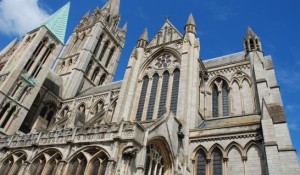All about aggregates.
Aggregates provide the backbone of our world. They are a raw material used in the manufacture of readymix concrete, asphalt, lime and mortar.
We are lucky to have a vast supply of aggregates in the UK. Here in Cornwall, Granite is the most popular, a very hard rock which was formed 450 million years ago. It is excavated from the ground by controlled explosions, at a quarry face. The blast creates a pile of aggregate, which is sent to a crushing area for processing. The aggregate goes through several crushers and screens to create various sizes for the cutomers requirements, and then stockpiled and sold to the customer.
Some of these aggregates get washed, such as sand and gravel, to make them cleaner before being stockpiled, and sold to the customer.
As a raw material, aggregates are Environmentally friendly, and are used by Builders, and Landscapers. They are found in road base construction and asphalt, building foundations and readymix concrete in footings, concrete blocks in walls, concrete lintels, and the construction of drives, pathes, and carparks, and decorative weed prevention in gardens.
Aggregates have been used in the construction industry for centuries.
The Roman Empire built a vast network of roads and aqueducts, and some can still be seen today.
Today with pressure on saving the Enviornment in peoples minds, aggregates are used even more efficiently, and are recycled for further use when they are salvaged from buildings and crushed for road construction.
 Aggregate is a raw material, which is hard wearing, and has been used to create lasting monuments such as Mount Rushmore, the presidents mountain in the Black Hills of South Dekota, USA. Doane Robinson wanted to create an attraction that would draw people from all of the country to his state. He contacted a sculptor called Gutzon Borglum, and together they planned the monument. Construction began in 1927 and was completed in 1941.
Aggregate is a raw material, which is hard wearing, and has been used to create lasting monuments such as Mount Rushmore, the presidents mountain in the Black Hills of South Dekota, USA. Doane Robinson wanted to create an attraction that would draw people from all of the country to his state. He contacted a sculptor called Gutzon Borglum, and together they planned the monument. Construction began in 1927 and was completed in 1941.
The Four Presidents carved in the mountain are George Washington, Thomas Jefferson, Theodore Roosevelt, and Abraham Lincoln. It cost 989, 992, 32 dollars to build.
Stonehenge in the UK
 Stonehenge is another aggregate monument. Built 3000 BC – 2000 BC, this prehistoric monument is located in Wiltshire, near Salisbury. It consists of stones standing in a circle. 30 were errected, as a 33metre diameter circle, with 30 stone lintels placed on the top.
Stonehenge is another aggregate monument. Built 3000 BC – 2000 BC, this prehistoric monument is located in Wiltshire, near Salisbury. It consists of stones standing in a circle. 30 were errected, as a 33metre diameter circle, with 30 stone lintels placed on the top.
Each standing stone was about 4.1 metres high and 2.1 metres wide, and weighed around 25 tons. They are 1.1 metres thick, and stand 1metre apart. A total of 75 stones would have been needed to complete the circle ( 60 stones ) and the trilithon inner horse shoe ( 15 stones ). Unless some of the sarsen stones have been removed, the ring appears to have been left incomplete. The lintels are each around 3.2 metres long, 1 metre wide, and 0.8 metres thick.
The tops of the lintels are 4.9 metres above the ground. Within the circle stood five trilithons of dressed sarsen stone arranged in a horseshoe shape. 13.7 metres across with it’s open end facing north east. These huge stones, ten uprights and five lintels, weigh up to 50 tons each. The smallest pair of stones were 6 metres high, and the largest 7.3 metres high. Today only one of these large stones remain standing.
There is numerous myths surrounding these stones, but no written records were kept when they were errected, or how they were errected, or the reason why they were erected. But today people from all around the world come and visit this great monument of stone.
Truro Cathedral, Cornwall
 Truro Cathedral is the only cathedral in Cornwall, Parliament passed it’s construction in August 1876. St.Mary’s Parish Church originally stood on this site, and was demolished along with numerous houses by 1880.
Truro Cathedral is the only cathedral in Cornwall, Parliament passed it’s construction in August 1876. St.Mary’s Parish Church originally stood on this site, and was demolished along with numerous houses by 1880.
In 1880 the Duke of Cornwall ( later Edward vii ) laid two foundations stones. The cathedral is made of granite stone from Cornwall, and the sculptures are made from Bath stone.
Tower Bridge, London.
 Tower Bridge was built in 1886 – 1894, and is a combined bascule and suspension bridge, over the River Thames. It is close to the Tower of London, which is how it got it’s name.
Tower Bridge was built in 1886 – 1894, and is a combined bascule and suspension bridge, over the River Thames. It is close to the Tower of London, which is how it got it’s name.
Two massive piers, containing over 70.000 tons of concrete, were sunk into the riverbed to support the construction. Over 11.000 tons of steel provided the framework for the towers and walkways. This was then clad in Cornish granite and Portland stone, both to protect the underlying steelwork and to give the bridge a pleasing appearance.
The cost of construction was £ 1,184,000, ( £100 million as of 2012 ). It is 800 feet long, with two towers each 213 feet high built on piers. The central span of 200 feet between the towers is split into two equal bascules or leaves, which can be raised to an angle of 86 degrees to allow river traffic to pass. The bascules, weighing over 1,000 tons each are counterbalanced to minimise the force required and allow raising in five minutes.
Tin Mine Engine House, Cornwall
 These engine houses were very important to the workforce underground.
These engine houses were very important to the workforce underground.
They are made from Cornish Granite stone, and housed large pumps which would draw up water from the many tunnels below ground. Mining in Cornwall began in the Bronze Age around 2,150 BC and ended with South Crofty tin mine in 1998. Cornwall and Devon provided most of the United Kingdom with tin, copper, and arsenic until the 20th Century.
The area around St.Day and at Porthtowen were among the richest mining areas in the world and at it’s height the Cornish tin mining industry had around 600 steam engines working to pump out the mines. Many mines stretched under the sea.
By late 19th Century, Cornish mining was in decline, and many miners emigrated to South Africa, Australia, and North America where their skills were in great demand. In 1875 over 10,000 miners emigrated.

